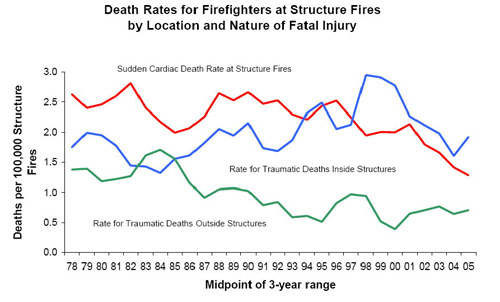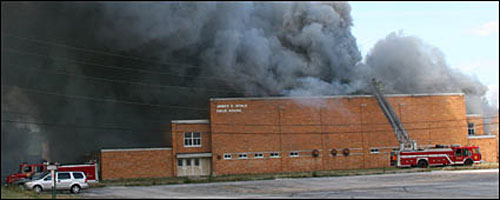Ventilation Tactics: Understanding and Application
Thursday, October 30th, 2008Second only to the great solid stream versus fog debate, ventilation strategies seem to create the most discussion and disagreement among fire service practitioners. Vertical or horizontal; natural, negative, or positive pressure; vent before, during or after fire control? These are all good questions (many of which have more than one answer).
The Importance of Why
BC Kriss Garcia recently published an interesting article titled Education vs. Training in Fire Space Control (Fire Engineering, September 2008) examining the difference between training and education, in particular as it relates to ventilation strategies. Kriss emphasized that we train to improve performance and efficiency, but use education to develop our ability to think and understand not only how, but when, why, and why not. Both are critical to today’s firefighters and fire officers.
Space Control
Firefighters sometimes perform ventilation operations by routine, executing tactics simply based on common practice without thought to the influence of these actions on the fire environment and fire behavior. Kriss emphasizes the importance of understanding the effect of changing the ventilation profile and its relationship to fire control, stating:
Absolute control of the space you are opening is necessary for a safe and effective fire attack. If firefighters cannot control the space with enough direct application of [British thermal unit] Btu -quenching water, they should not be opening the space, encouraging additional free burning.
The concepts included in this brief statement are critical, but could be expanded and clarified a bit.
- Developing and maintaining control of the space is critical to offensive firefighting operations and the survival of civilian fire victims who may be trapped in the building.
- Increasing the air supply to a ventilation controlled fire will increase the heat release rate. Heat release rate is measured in kilowatts (kW) or British thermal units (Btu)/m.
- Water application in liters or gallons per minute (lpm or gpm) must exceed the critical rate of flow based on the heat release rate (kW or Btu/min) developed by the fire.
There are two key differences in this expanded outline of the importance of understanding the influence of changing the ventilation profile: 1) Recognizing and understanding the dominant influence on current fire development, fuel or ventilation. Heat release rate from a fire burning in the ventilation controlled burning regime will increase if the fire receives additional air. 2) Water application (lpm or gpm) must be sufficient to overcome the heat release rate from the fire. While it is common to hear firefighters say that gpm must overcome Btu, this is not completely correct. Btu is a measure of energy much the same as liters or gallons is a measure of the volume of water. Kilowatts (1000 joules/second) or Btu/minute are a measure of heat release rate as lpm or gpm are a measure of water application rate.
Tactical ventilation is the other element of space control. Smoke contains unburned pyrolizate and flammable products of incomplete combustion, and as such is fuel. Hot fuel gases overhead can be cooled, providing a buffer zone around the nozzle team, but only when smoke is removed through tactical ventilation is this hazard fully mitigated.
Understanding is Critical
The difficulty that some firefighters have in accepting positive pressure ventilation or positive pressure attack is frequently rooted in a lack of understanding. In some cases, this based on dogmatic attachment to other tactical approaches. In other cases, it is a result of too much training (how to do it) and not enough education (why, why not, and when). Kriss emphasizes the value of positive pressure ventilation and the need to balance training and education to develop both skills proficiency and understanding.
Friendly Criticism
The concluding paragraph of Kriss’s article Education vs. Training in Fire Space Control (Fire Engineering, September 2008) makes two strong statements.
Regardless of the approach we use to safely control fires, we must maintain as the basis of all discussions our ability to control the fire space prior to opening it. The most dramatic means of accomplishing this is through control of the interior environment with [positive pressure attack] PPA and direct water application.
I am fully in agreement with the first sentence. Maintaining control of the fire space is absolutely critical to safe and effective offensive operations. However, the second sentence, which so emphatically supports PPA integrated with direct attack without qualifying the conditions under which this tactic should or should not be used, could be a bit misleading. Under many conditions, PPA and direct attack will be extremely effective. In other circumstances, these tactics are not appropriate. For example, Positive Pressure Attack for Ventilation and Firefighting by Garcia, Kauffmann, and Schelble, identifies several contraindications to use of PPA, inclusive of victims in the exhaust opening or other area which may be threatened and extremely ventilation controlled fire conditions which may present risk of backdraft.
The metaphor of the silver bullet applies to any straightforward solution perceived to have extreme effectiveness. The phrase typically appears with an expectation that some new technology or practice will easily cure a major prevailing problem. (Wikipedia)
In firefighting there are no silver bullets. Increased understanding of the theoretical foundations of fire behavior and the influence of ventilation and applied research such as that done by the National Institute for Standards and Technology are the key to effective use of ventilation strategies and improving the safety and effectiveness of fireground operations.
Firefighters should not uncritically accept current practice. Neither should firefighters accept new or different approaches without the same thoughtful and critical examination. Not just what and how, but why! Kriss’s Positive Pressure Attack website has a wide range of resources related to positive pressure ventilation and positive pressure attack. As Kris advises, both education and training are critical to safe and effective firefighting. Positive pressure attack is an extremely powerful tool when used correctly, be a student of your craft and learn not just what and how, but why!
Kris also published an article titled The Power of Negative Thinking in October issue of FireRescue magazine. This article takes a look at how pressure differences inside and outside the fire building influence ventilation. This interesting article will be the focus of a future post.
Ed Hartin, MS, EFO, MIFireE, CFO




